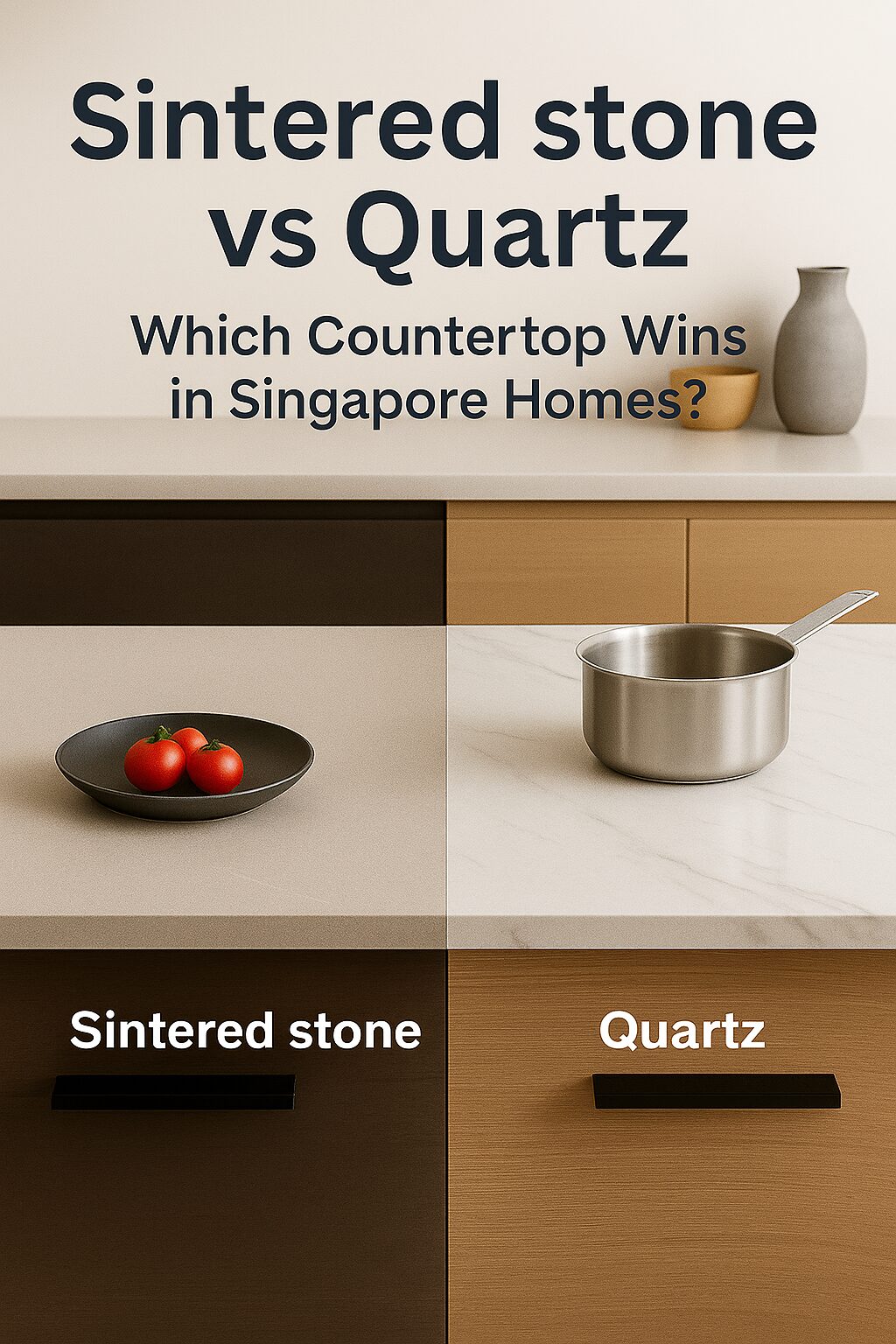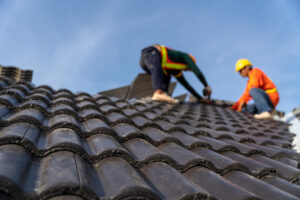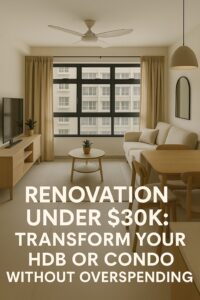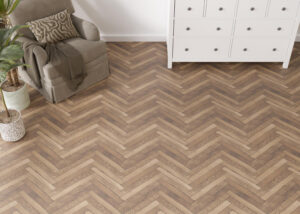Table of Contents
Planning a renovation in Singapore? Whether you’re upgrading your HDB kitchen, designing your condo’s dry kitchen, or setting up an alfresco counter on your balcony — choosing the right countertop material is a big deal.
Two names usually top the list: Quartz and Sintered Stone.
They look similar, but don’t be fooled — they behave very differently in real-life Singapore conditions. We’re talking about:
Humid kitchens
Piping-hot cookware
Curry stains
Outdoor UV exposure
This guide is your no-BS comparison of quartz vs sintered stone, tailored for local homes and lifestyles. We’ll break down:
Costs in SGD (installed)
Heat & stain resistance
Outdoor durability
Which one works better for Singapore’s tropical weather and cooking habits
If you’ve been asking, “What’s the difference between sintered stone and quartz?”, or “Which countertop is better for my Singapore kitchen?”, this guide is for you.
🔥 Heat Resistance: Can Your Countertop Handle the Heat?
Let’s be real — Singapore kitchens see some serious heat.
We’re not just boiling water here. We’re:
Stir-frying sambal on a roaring flame
Dropping woks straight from the hob
Baking pineapple tarts at 200°C and needing somewhere to place that tray
So how do these materials hold up?
🧪 Quartz: Pretty Tough… But Not Heat-Proof
Quartz is durable, but it’s not invincible. It’s made from crushed stone bound by resin, and resin doesn’t like extreme heat. Place a hot pot directly on a quartz counter and:
You could get scorch marks
The resin might warp or “bloom” over time
Discoloration may happen if it’s repeated often
💡 Tip: Always use a trivet or wooden board under hot cookware.
🔥 Sintered Stone: Born for Heat
Sintered stone is made by compressing minerals at extreme temperatures — over 1,200°C. In simple terms, it’s already been through the fire, so heat doesn’t scare it.
You can:
Place a hot wok directly on it
Rest your baking tray straight from the oven
Use it for BBQ prep outdoors
No burn marks. No cracking. No drama.
🏆 Verdict for Singapore Homes:
| Habit | Best Choice |
|---|---|
| You always use trivets or boards | Quartz is fine |
| You’re the type to dump hot pots straight onto the counter | Sintered stone is safer |
| You have a hob on your island top | Definitely sintered stone |
| You’re planning an outdoor wet kitchen or BBQ counter | Sintered all the way |
🧽 Stain & Scratch Resistance: Which One’s More “Life-Proof”?
Your countertop isn’t just for show — it’s the busiest surface in your home. So ask yourself:
Can it handle curry spills, durian cutting, red wine nights, and the occasional toddler with a fork?
Let’s break it down:
🍛 Stain Resistance
Quartz:
Non-porous thanks to its resin binder
Resists everyday stains like coffee, ketchup, and soya sauce
BUT: Harsh cleaners (like strong bleach) can damage the resin over time
Some cheaper quartz may show dull patches if exposed to acidic cleaners
Sintered Stone:
100% mineral and non-porous — no resins, no sealants needed
Extremely stain-resistant even against turmeric, red wine, sambal, or oil splatters
Completely safe with bleach, vinegar, and degreasers
💡 Singapore tip: If your cooking includes curry, soy, or sambal, sintered stone gives extra peace of mind.
🔪 Scratch Resistance
Quartz:
Very hard (Mohs hardness 6–7), handles knife nicks and rough use
Still, it can scratch under extreme pressure or from sand/grit
NOT a replacement for a chopping board
Sintered Stone:
Harder than most natural stones (Mohs 7–8)
Almost scratch-proof in day-to-day use — think keys, knives, and even dragging pans
That said, always use a board — even diamonds scratch diamonds
🏆 Verdict for Singapore Kitchens:
| Scenario | Best Option |
|---|---|
| You’re a casual home cook | Quartz holds up well |
| You prep spicy food daily or cook without cleaning immediately | Sintered is safer |
| Kids + knives + homework on the kitchen counter? | Sintered gives peace of mind |
| You want maximum stain resistance without worrying about cleaners | Sintered stone wins |
☀️ Outdoor Use & UV Resistance: Can Your Countertop Survive the Balcony?
In Singapore, space is tight — so many homeowners make full use of:
Balcony BBQ counters
Service yards with sinks
Outdoor wet kitchens in landed or patio homes
But not all countertops are made to handle sun, rain, and tropical humidity.
🌤️ Quartz: Keep It Indoors
Quartz is a superstar indoors, but once exposed to direct sunlight or rain:
UV rays can cause yellowing or fading over time
Moisture may seep into joints and weaken the resin
Most quartz manufacturers do not warranty outdoor use
Even a semi-outdoor area with morning sun can affect how your quartz top ages.
🌞 Sintered Stone: Built for the Outdoors
Sintered stone is engineered to survive harsh conditions — including outdoor façades and high-rise cladding. In Singapore’s climate:
UV-resistant – colour won’t fade, even in direct sun
Waterproof – no swelling, bubbling, or warping
Handles extreme heat, heavy rain, and sudden temperature changes
💡 Perfect for: Outdoor wet kitchens, balconies, BBQ prep counters, and even shower ledges.
🏆 Verdict for Singapore Homes:
| Outdoor Use | Best Option |
|---|---|
| Indoor kitchen only | Quartz is perfect |
| Semi-outdoor areas (service yard, shaded balcony) | Sintered is safer |
| Full sun or exposed rain (outdoor wet kitchen, BBQ zone) | Definitely sintered stone |
| Want a single material for both indoor and outdoor use | Sintered gives uniformity |
🎨 Colour Options & Design Flexibility: Which One Matches Your Style?
Countertops aren’t just functional — they’re also a big part of your kitchen’s aesthetic. Whether you’re going for Japandi, industrial chic, or classic white-and-gold, your surface needs to look right.
So which material gives you more creative freedom?
🌈 Quartz: Unlimited Choices
If you’ve got a Pinterest moodboard, chances are quartz has something that matches it.
Comes in hundreds of colours — from soft pastels to jet black
Mimics marble, terrazzo, concrete, and more
Customisable patterns and finishes (matte, glossy, leathered)
Easier to colour-match across other surfaces (backsplashes, table tops)
💡 Perfect for homeowners with a very specific aesthetic in mind.
🎨 Sintered Stone: Realistic Stone Looks, Less Variety
Sintered stone focuses more on high-end, natural stone looks.
Think elegant veining, warm taupes, sleek charcoals
Limited colour range compared to quartz
Strong emphasis on texture — many slabs come in soft matte or “satin” finishes that feel like natural stone
You won’t find bold turquoise or funky terrazzo styles here — but you’ll get a premium, architectural look.
🏆 Verdict for Singapore Interiors:
| If you want… | Best Choice |
|---|---|
| Maximum colour selection | Quartz |
| A specific marble or concrete look | Both are good – depends on brand |
| Sleek, premium matte textures | Sintered stone |
| Something bold, colourful or trendy | Quartz wins |
| A cohesive, stone-like finish across the home | Sintered looks more natural |
💰 Cost Comparison: How Much Will It Actually Cost in Singapore?
Let’s face it — in any renovation, the big question is:
“How much is this going to cost me?”
The countertop price depends on more than just the material. You’ll also pay for:
Cutting and polishing
Edge profiling
Cut-outs for sinks, hobs, or pop-up sockets
Installation and site handling
So let’s break it down clearly.
💵 Quartz: Budget-Friendly & Widely Available
Quartz is widely stocked in Singapore, with tons of fabricators ready to install it quickly. That means:
Competitive prices
Easier to fit into HDB/condo renovation bundles
Often included in ID packages as the default countertop
Average installed cost:
🟢 $50 – $150 per square foot
🔹 10 ft kitchen counter (with sink cut-out): ~$4,000 – $6,000
🔹 Kitchen island: ~$5,000 – $8,000
💡 Want a good deal? Look for quartz options bundled into full kitchen packages — especially in mass-market showrooms or Carousell suppliers.
💵 Sintered Stone: Premium Price Tag, Premium Performance
Fewer fabricators in Singapore work with sintered stone — it needs special diamond tools and careful handling. But you get:
Greater durability
Longer warranties
Higher resale appeal (especially in luxury condos)
Average installed cost:
🟡 $80 – $120 per square foot
🔹 10 ft kitchen counter: ~$5,500 – $7,000
🔹 Kitchen island (large format): ~$6,500 – $10,000
🔹 Outdoor wet kitchen (2m): ~$2,200 – $3,200
💡 If you’re already upgrading your appliances and finishes, sintered is a long-term investment.
🏆 Verdict for Singapore Renovators:
| Renovation Scenario | Best Fit |
|---|---|
| BTO or resale flat with tight budget | Quartz |
| Standard condo kitchen with ID bundle | Quartz |
| High-traffic home with kids or rental units | Sintered (less maintenance long term) |
| High-end condo, landed property, or outdoor kitchen | Sintered is worth the upgrade |
🛠️ Installation, Fabrication & Worker Safety: What You Don’t See (But Should Know)
You’ve picked your material, but here’s what most IDs don’t tell you:
Some surfaces are harder to fabricate.
Some take longer to install.
And some pose serious health risks during cutting.
Let’s pull back the curtain.
⚙️ Quartz: Fast Turnaround, Widely Available
Quartz is the standard choice in Singapore because:
Almost every stone supplier and fabricator knows how to cut and install it
It can be dry-cut (although wet cutting is safer — more on that below)
Turnaround is fast – some IDs can install within 1 week of template confirmation
💡 If your reno is on a tight deadline, quartz is usually easier to coordinate.
⚙️ Sintered Stone: Precision Needed, Longer Lead Time
Sintered stone is tougher — literally.
Requires special diamond blades and wet-cutting techniques
Fewer experienced fabricators in Singapore
Slabs are often thinner but denser — and more brittle during handling
Cutting mistakes = costly replacements
Expect a longer lead time (usually 1–2 extra weeks) compared to quartz.
💡 Work with fabricators certified by brands like Dekton or Neolith — not every shop is equipped.
😷 Health & Worker Safety: Silica Dust Is a Real Thing
This matters more than most homeowners realise.
Quartz:
Contains up to 90% crystalline silica
When dry-cut, it releases fine silica dust
Long-term exposure can cause silicosis, a serious lung disease
Singapore’s Workplace Safety and Health (WSH) regulations now limit exposure to 0.1 mg/m³ TWA
Wet cutting and proper PPE (N95 masks, ventilation) are a must
Sintered Stone:
Has lower silica content
Produces less dust overall
Safer for fabricators when cut properly
💡 Ask your contractor or ID: “Do your workers cut quartz dry or wet?” — A responsible one will always answer “wet.”
🏆 Verdict for Homeowners in SG:
| Concern | Go With |
|---|---|
| Fast installation, mass-market availability | Quartz |
| Complex layouts or premium kitchens | Sintered (with skilled fabricator) |
| Tight handover deadline | Quartz is safer |
| You care about safety & eco-ethics | Sintered has lower silica risk |
🌱 Eco-Friendliness & Sustainability: Which Surface Is Greener?
Whether you’re aiming for a Green Mark-certified home, reducing your carbon footprint, or just want a healthier space for your family — it’s worth asking:
What’s actually inside these countertops, and how sustainable are they?
♻️ Quartz: Engineered with Resin, High Silica Content
Quartz surfaces are man-made with:
~90% natural stone (usually quartz or granite chips)
~10% polymer resin (petroleum-based)
Pigments and sometimes VOC-emitting binders
Environmental impact:
Resin production = fossil fuel usage
High crystalline silica content = greater fabrication dust risk
Not easily recyclable
Most don’t disclose full environmental certifications
💡 Good brands (like Caesarstone) now offer “low-silica” ranges and Greenguard Gold certification – but not all quartz in SG meets these standards.
🌍 Sintered Stone: Natural Minerals, No Resin, Fully Recyclable
Made by compressing pure clays, feldspar, silica, and mineral pigments — no polymers, no glue, no nonsense.
Why it’s more sustainable:
No VOCs – safe for indoor air even when newly installed
Can be ground down and recycled like stone or ceramic
Often contains recycled content
Brands like Dekton and Lapitec are certified carbon-neutral or EPD-declared
💡 Best for health-conscious households, allergy-sensitive users, or those designing Green Mark or eco-conscious interiors.
🏆 Verdict for Green Homes in Singapore:
| Eco Factor | Best Option |
|---|---|
| Low-VOC and safe for indoor air | Sintered stone |
| Lower silica risk during fabrication | Sintered stone |
| Recyclable material | Sintered stone |
| Budget eco-option with Greenguard rating | Premium quartz brands only |
✅ Final Comparison: Sintered Stone vs Quartz (Singapore 2025)
Here’s everything we’ve covered — simplified into a side-by-side cheat sheet:
| Feature | Quartz | Sintered Stone |
|---|---|---|
| 💸 Cost (installed) | $50 – $150 / sqft | $80 – $120 / sqft |
| 🔥 Heat Resistance | Moderate – may scorch | Excellent – 300°C+ |
| 🧽 Stain Resistance | High, but resin-sensitive | Ultra-high, bleach-safe |
| 🔪 Scratch Resistance | Strong | Even stronger |
| ☀️ UV Resistance | Not UV-proof | UV-proof – outdoor rated |
| 🌧️ Outdoor Use | Not recommended | Built for it |
| 🎨 Colour Variety | Wide range | Limited, natural tones |
| 🛠️ Fabrication Speed | Fast & common | Slower, more precise |
| 😷 Worker Safety | High-silica dust risk | Low-silica, safer |
| 🌱 Eco-Friendliness | Resin-based, less recyclable | No resin, recyclable, low VOC |
🧠 So… Which One Should You Choose?
| If You… | Go With |
|---|---|
| Have a tight reno budget | Quartz |
| Want trendy colours or a custom hue | Quartz |
| Cook with high heat and want zero stress | Sintered Stone |
| Have an outdoor kitchen or balcony counter | Sintered Stone |
| Are big on sustainability and low-VOC homes | Sintered Stone |
| Need fast installation with an ID package | Quartz |
| Want peace of mind against stains & scratches | Sintered Stone |
🛒 Bonus Tip: Mixing Materials = Smart Cost Savings
Can’t decide? Many Singapore homeowners now mix both materials:
Quartz for main counters
Sintered stone only where it matters (hob zone, island, or outdoor)
That way, you stay within budget — without compromising on performance where it counts.




